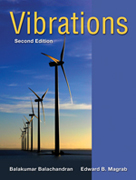
Featuring outstanding coverage of linear and non-linear single degree-of-freedom and multi-degree-of-freedom systems, this book teaches the use of vibration principles in a broad spectrum of applications. In this introduction for undergraduate students, authors Balakumar Balachandran and Edward B. Magrab present vibration principles in a general context and illustrate the use of these principles through carefully chosen examples from different disciplines. Their balanced approach integrates principles of linear and nonlinear vibrations with modeling, analysis, prediction, and measurement so that physical understanding of the vibratory phenomena and their relevance for engineering design can be emphasized. The authors also provide design guidelines that are applicable to a wide range of vibratory systems. MATLAB is thoroughly integrated throughout the text. INDICE: Chapter 1: Introduction 1.1 Introduction 1.2 Preliminaries from Dynamics 1.3 Summary Exercises Chapter 2: Modeling of Vibratory Systems 2.1 Introduction 2.2 Inertia Elements 2.3 Stiffness Elements 2.4 DissipationElements 2.5 Model Construction 2.6 Design for Vibration 2.7 Summary Exercises Chapter 3: Single Degree-of-Freedom Systems: Governing Equations 3.1 Introduction 3.2 Force-Balance and Moment-Balance Methods 3.3 Natural Frequency and Damping Factor 3.4 Governing Equations for Different Types of Damping 3.5 Governing Equations for Different Types of Applied Forces 3.6 LagrangesEquations 3.7 Summary Exercises Chapter 4: Single Degree-of-Freedom System: Solution for Response and Free-Response Characteristics 4.1 Introduction 4.2 Free Responses of Undamped and Damped Systems 4.3 Stability of Single Degree-of-Freedom System 4.4 Machine Tool Chatter 4.5 Single Degree-of-Freedom Systems with Nonlinear Elements 4.6 Summary Exercises Chapter 5: Single Degree-of-Freedom Systems Subjected to Periodic Excitations 5.1 Introduction 5.2 Response to Harmonic Excitation 5.3 Frequency-Response Function 5.4 Systems with Rotating Unbalanced Mass 5.5 Systems with Base Excitation 5.6 Acceleration Measurement: Accelerometer 5.7 Vibration Isolation 5.8 Energy Dissipation and Equivalent Damping 5.9 Response to Excitation with Harmonic Components 5.10 Influence of Nonlinear Stiffness on Forced Response 5.11 Summary Exercises Chapter 6: Single Degree-of-Freedom Systems Subjected to Transient Excitations 6.1 Introduction 6.2 Response to Impulse Excitation 6.3 Responseto Step Input 6.4 Response to Ramp Input 6.5 Spectral Energy of the Response 6.6 Response to Rectangular Pulse Excitation 6.7 Response to Half-Sine Wave Pulse 6.8 Impact Testing 6.9 Summary Exercises Chapter 7: Multiple Degree-of-Freedom Systems: Governing Equations and Natural Frequencies and Mode Shapes 7.1 Introduction 7.2 Governing Equations 7.3 Free Responses 7.4 Rotating Shafts on Flexible Supports 7.5 Stability 7.6 Summary Exercises Chapter 8: Multiple Degree-of-Freedom Systems: General Solution for Response and Forced Oscillations 8.1 Introduction 8.2 Normal-Mode Approach 8.3 State-Space Formulation 8.4 Laplace Transform Approach 8.5 Transfer Functions and Frequency-Response Functions 8.6 Vibration Absorbers 8.7 Vibration Isolation: Transmissibility Ratio 8.8 Systems with Moving Base 8.9 Summary Exercises Chapter 9: Vibrations of Beams 9.1 Introduction 9.2 Governing Equations of Motion 9.3 Free Oscillations: Natural Frequencies and Mode Shapes 9.4 Forced Oscillations 9.5 Summary Glossary Appendix A Laplace Transform Pairs B Fourier Series C Decibel Scale D Solutions to Ordinary Differential Equations EMatrices F Complex Numbers and Variables G Natural Frequencies and Mode Shapes of Bars, Shafts, and Strings Answers to Selected Exercises Index
- ISBN: 978-0-495-41125-3
- Editorial: Wadsworth Publishing
- Encuadernacion: Rústica
- Páginas: 640
- Fecha Publicación: 30/12/2008
- Nº Volúmenes: 1
- Idioma: Inglés
